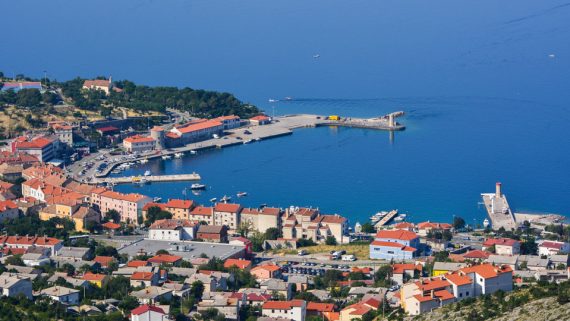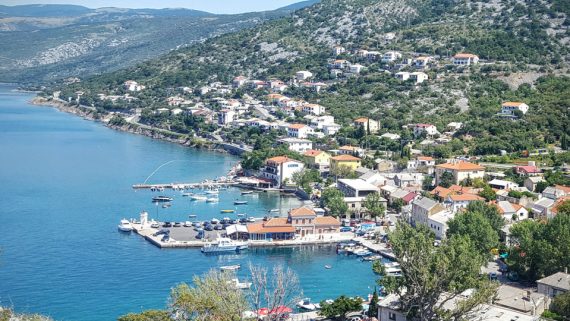Senj


About Senj
Location and Climate
The town of Senj is the largest urban anglomeration on the Croatian coast beetwen Rijeka and Zadar. The town area comprises the maritime coast which is 76 km long and is situated beetwen the sea and the slopes of Kapela and Velebit (Velebit is the biggest mountain in Croatia). It’s at 14° 54′ 10” east longitude and 44° 55′ 24” north latitude. Its position on the Eastren Adriatic coast determines its maritime connection with the
Mediterranean towns and countries. It’s linked with the hinterland by the roads across the Vratnik pass (700m above the sea level) in the North, but also with the Vinodol Valley and Rijeka in the West and with Zadar, Split and southren Dalmatia in the South.
Northern Croatia has the continental climate. Central Croatia has pre-mountainous and mountainous climate, and the coastal area has the Mediterranean climate (with dry and warm summers, and mild and humid winters).
The temperatures (in degrees Celsius) in winter range from -1° to 3°C in the continental zone, from -5° to 0°C in the mountain region, and from 5° to 10°C in the coastal region.
The temperatures (in degrees Celsius) in summer range from 22° to 26°C in the continental part of the country, 15° to 20°C in the mountain region, and 26° to 30°C in the coastal region.
With 2.600 hours of sunshine per year, the Adriatic Coast is one of the sunniest in the Mediterranean. The temperature of sea during the summer season is 25° to 27°C.
The most common winds are the north-eastern wind called bura that brings cold weather, the landward breeze called maestral, which announces nice weather and starts blowing at around 11AM, and jugo, the humid wind that blows from the southeast.
History
Senj is an old settlement which was founded on the hill Kuk, east of the town more than 3000 years ago. In the pre-historic times under the fortificated settlement, on the place where the brook flows into the sea bay, there was a port and a trade cener, a place where people coming from different directions (inland, islands and the coast) could exchange their goods. As the importance of the place gradualy grew, the settlers from the hill moved nearer and nearer to the sea forming there a new place which was mentioned for the 1st time in 4th century B.C. It was the Greek sailor and a writer Pseudoskilaks who mentioned the place under the name of Attienities. In the 2nd century B.C. the Romans came and little by little they overtook the control over the town which was at that time known as Senia. From Senia they could easily attack the Japods and other Illyrian tribes whichwere in the inlad. But, the Romans didn’t lead only wars. They continued to buikd the town especially from the second half of the 1st century B.C. till the 4th century. During that period Senia become the most important port and the main trading, cultural centre of this part of Adriatic coast. The Town hall, an aqueduct, thermes, temples ( to the Gods and Godesses Diana, Magna Mater, Kibela and Liberus) and many other objects build at that time which we can trace in numerous archeological findings such as stone monuments, sculptures of Gods and Godesses, pieces of architectural works and tomb stones.
During the 5th, 6th and 7th centuries, when the Migration took pleace, many Barbarian tribes from the East invaded the town breaking its golden age. Due to the danger of the Barbarian invasion, the number of inhabitants decreased and the economic power of the town was dropping more and more. It was the era of tension and disorder. There was no more prosperity and it was, most probably, robbed and burned down during thease Barbarian attacks. We cannot be sure which tribe did it but it was very likely that West Ghots started the process of destruction which was completed by the Avaris and the Slavs at the begining of the 7th century. In the 17th century, the Croats along with the Avars settled down on the ruins of the Roman Senia and they established the mediaeval settlemant called Senj which in its name preserved the Roman tradition. This part of history from the 6th to the 10th century is not known. Center of the Mediaeval Croatian state was moved to the south (in Dalmatia) and Senj lost its omportance.Much later, after graviting Pacta Conventa in 1102. The political power moved towards the North, Senj become once again prosperius town. It was a part of the Ugro-Croat kingdom. In 1169. The diocese was established and it clearly points on the importance of the town.
In 1184., owing to the Hungarian king Bela the 3rd who gave Senj as a present to the Templares, the order of priests and knights, the town was in their possession for the next seventy years. After the Templares, from 1271. on, Senj was ruled by the Dukes of Krk who were later renamed the Frankopans. The town becomed prosperious both in its economic and cultural life. A large number of sacred and profane structures were built not only in the tiwn but in its surrounding as well.
In the Mediaeval age Senj is known for its glagolic alphabet, the alphabet which had alredy been created in the 9th century for the need of the Slavs. From the 12th century on the glagolic alphabet exsisted only on the Croatian soil and it was particulary developed in the area of Senj. In 1248. The Bishop of Senj got a permision from the Pope Inocent the 4th and become the only Bishop who was allowed to use the glagolic alphabet and the people’s language in his liturgy service. This fact influenced the development of the glagolic alphabet during the 14th and 15th centuries so we have many glagolyan stone board and hand written books and documents. A glagolic printing press was established in Senj in 1494. Which was one of the earliest printing press houses in southeast Europe. Two incunabues “The Glagolic Missal” and “Spovid općena” were printed at that time.In the middle of the 15th century the millitary forces of the Hungarian-Croatian king Matija Korvin came to town. In the 1469. Senj became a center of its captaincy, established because of danger which was coming closer and closer from the Turks but also with the aim to defend from the policy of Venice. The Ottoman campaigns to this area were especially during the firs half of the 16th century. At that time the neighbouring places were totally devasteded and the town became the refuge for a large number of refuges from the occupied areas. The millitary units were formed of the refuges. They were the famous Uskoks who successfully defended Senj till the twenties of the 17th century and who managed to cause hard lossesto the armed forces of the Ottoman Empire and Venice. In 1558. A construction of the fortress Nehaj, on the hill Trbušnjak, was finished for the needs of defence. The Uskoks was placed there. Because of the heroic resistance to much stronger enemy, these brave worriors got into the legend and folk songs. In the 17th century they became disturbance and a danger to a new peaceful policy of the Habsburg Monarchy towards the Ottoman Empire and Venice, and were evacuated to the other places in Croatia. Peaceful times enabled a restoration of trade in Senj and with that economic prosperety of the town wes provided. That was especially expressed in the second half of the 18th century and in the first half of the 19th century, when the great constructive works were being taken out (construction of the new Josephina’s road, restoration of the port, construction of the big imperial depot, regulation of the strong current and similar works). At that time started the golden age of the town which became one of most important in the country. The import of salt and export of grain and wood were passing through that port. The sailors fromSenj sailed on their ships all over the world and they traded especially intensive with the Mediterranean countries. The entrepreneurs and labour came to that properus town; the comercial and shipbuilding companies, chamber of commerce, chamber of trades were founded and the important cultural activity was developed. Also the town music society, the reading club and other cultural organisations were founded. Senj became an important cultural center and its intellectuals and inhabitans were bearers of the Croatian national ideology. The most famous Croatian writers and poets were born and lived there: Silvije Strahimir Kranjčević (1865.-1908.), Vjenceslav Novak (1859.-1905.), Milutin Cihlar Nehajev (1880.-1931.) and Milan Ogrizović (1877.-1923.). Their busts can be seen in the Poet’s Park in Senj. The construction of the railway line Karlovac- Rijeka (1873.), which went round Senj, had the disastrous consequences for the economy and comertial meaning of the town. The traffic in the port was very reduced and the goods took another direction to Trieste and Rijeka. These two towns were connected with the hinterland by the railway-lines. The rde of Senj was reduced just to an export port for wood. The obscene of the economic prosperety and marginalization of the traffic direction had a negative effect on the town life and the life of the neighbourhood. In the late 19th century a migration of the inhabitants started. It was very intensive in the 20th century, especially after the end of the World war II, when political reasons were added to the economic reasons. The old town center suffered a great damage in bombing, when many of the extraordinary valuble cultural inheritance desappeared. But still many are preserved to the present days and they make Senj worth visiting both for domestic and foregin tourists.
 English
English Hrvatski
Hrvatski